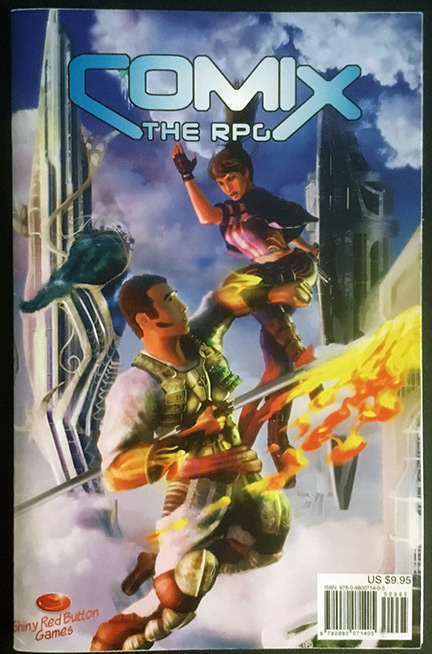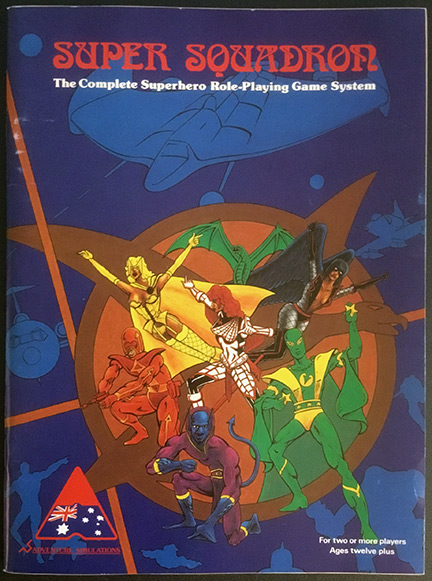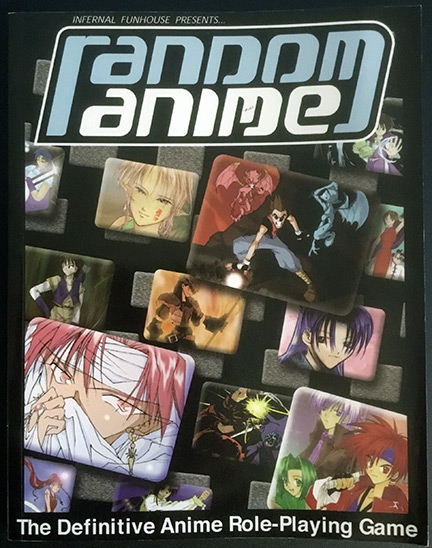This is part 7 in a series discussing forgotten RPGs (Part 1 can be found here, Part 2 here, Part 3 here, Part 4 here, Part 5 here, and Part 6 here). That is, games most people have never heard of or that didn't last long on store shelves for one reason or another. This batch focuses on superhero and anime games. Most of these games have been sitting on my shelf for years, mostly ebay finds to add to my collection.


1. Comix: The RPG (by Anthony Parisi; published by Shiny Red Button Games in 2008)

This is a small book, only 50 pages in length. It is reminiscient of the Marvel Superheroes Saga game in its layout. It starts with a quick reference for character creation. Characters get 5 Stats; agility, brawn, moxie, smarts, and charm. There are two parts to each Stat, a rating (1-5) and a quality (these are kind of like aspects or specialties, rated good, bad, or normal). Single-letter abbreviations are used for the qualities, making it a bit cumbersome to keep checking on what they are. Each power is linked to a Stat/Quality, although this can be fluid. I started getting a little confused here. Powers are open-ended, which means you can create your own based on the concepts laid out. It's actually easy to create a character, but the sample process is a must-read. A dice pool is used for all actions, with the type of die determined by the setting, difficulty (level of randomness), and certain game elements. The dice are totaled with the highest value exploding on each. The concept of open checks and set checks makes sense, but determining what must be rolled needs about four re-reads. There's a table incorporating ratings and die types to determine difficulty, but it's not explained too well. It seems that a difficulty number can be computed based on an opponent's rating and die type. Then there's kicks and successes. There's a table for that, or reduce how much the roll was over what was needed by the highest result possible on the type of die rolled as many times as possible -- the number of times this can be done is the kicks and the remainder is the successes. The former is a narrative mechanism, while the latter is enforced by the specific action taken. The rest of the book discusses rules and some advice. I don't really understand the need for two different types of success indicators, but maybe I'm just missing something. It actually gets a lot done in a little space, but could be greatly simplified in its execution.




2. Enforcers (by Gary Bernard, Charles Mann, and Larry Troth; published by 21st Century Games in 1987)

This is billed as a super-powered science fiction RPG. It is intended to be played in a future setting. A calculator is recommended. There are six basic statistics (4d6, drop lowest): strength, constitution, agility/dexterity, intelligence, and comeliness. Yes, that is only five. There is also media rating, but this uses a different scale, with positives and negatives. Then we get to damage number (using character points beyond a base of 10), which is multiplied by the R-factor (2d6) to determine how much damage is inflicted for any given attack. There are formulas present at this point to determine how much extra it will cost in creation points and energy points. Lots of superpower descriptions, followed by weaknesses. Now we get to calculated statistics, which include hit points (more calculations and fractions), energy points, carry capacity, hand to hand, running speed, detective score, danger sense, healing rate, and knock back factor. Sheesh. All need to be calculated with formulas and fractions. Next is occupations and skills. I'm not even going to continue. This game is not for me. I don't mind a few calculations here and there (Supergame Classic requires a formula for combat and damage, but this is over the top). I do like the critical hit and fumble tables. I bet the system is not as complex as it appears to be, but I don't really want to figure it out. Showing its age, they included a Lotus spreadsheet script for character generation. There's also a striking lack of any type of setting, so other than gadgets being the powers, I don't see how it is science fiction -- it could just as easily be fantasy. Let me just finish up with the reference pages including A LOT of numbers. Strike that, I will finish up with the character sheet reminding me of early Champions, and the formulas are listed on it, so doing all the calculations on the sheet is probably not as bad as I made out (provided, you know what you are doing).




3. Heroes & Heroines (by James E. Freel III; published by Excel Marketing in 1993)

We're starting out pretty good with explaining comic book characters. There are five prime characteristics: bench press weight (actual weight), IQ (actual IQ), reflexes, agility, and stamina. The numbers for the latter three seem to range from 3 to 100+. Various modifiers are created by these values (like D&D). Powers work similarly, with ranges, weights, and damage costing a certain amount of points. Powers continue up to page 85. Combat is handled with a d20, rolling over a value determine on a table by cross-referencing attack and defense values. It's actually a pretty easy system, but I haven't been able to find anything on performing normal actions. A selection of animal stats is included, as is a sample adventure. This would have been simpler than most superhero games back then, and had a few supplements. If I had it back then, I might have tried it.




4. Super Squadron (by Joseph Italiano; published by Adventure Simulations in 1983)

I've been told that this game is still popular in certain parts of the world, but I haven't heard much about it locally. The picture shown is one of the main book, but it came in a boxed set with other materials, including an adventure book. This is another future-era setting, but actually includes information on the setting (unlike Enforcers). There are eight principle characteristics: strength, agility, charisma, intelligence, stamina, public standing, ego, and luck. Public standing starts at 11 and luck uses a table, but the others are determined by rolling a d20 (rerolling if enough are too low). The character's origin is important, and powers are rolled randomly. As with D&D, characteristics apply modifiers to certain actions based on their values. A D% roll is made for attacks, with various modifiers applied. There is a lot of good mechanical advice included, such as for imprisonment, social involvements, and daily activities. It's not my ideal game, but it has a lot of great ideas. A super-science supplement was also published for it, with tech for the setting.




5. RandomAnime (by Brian J. Perry; published by Infernal Funhouse Productions in 2002)

Unlike the previous entries, this is a game about playing anime characters. We start out with a discussion of anime, roleplaying, and a glossary of terms. There are various levels of anime, which describe the amount of realism and suspension of disbelief. Characters are built with templates (like big bruiser, idol, kid, and old master) to determine bonus points and luck. There are eight attributes (rated from 1 to 10): strength, reflexes, endurance, perception, intelligence, wits, charisma, and resolve. The realm of anime (shojo, shonen, or sentai) determines how many points to allocate. Then come the skills in a similar manner. Backgrounds add more detail to the character, as do gimmicks (like bulletproof, mind trick, and teleport). After all the descriptions for skills and gimmicks are given, we get the mechanics on page 114. Yes, page 114. For actions, three six-sided dice are rolled: two are added together, while the third is a luck die and kept separate. If the modified 2d6 roll is equal to or greater than 10, the action is a success. The luck die can decide draws and apply extra damage -- it is just what it seems to be: a lucky die. Combat is handled similarly, with the attacker's difficulty (instead of 10) being equal to the defender's total. Most gimmicks and actions are divided into mechanical, cinematic, and mecha specifics, so various styles of play are supported. This is a pretty expansive and simple game. It probably lacks some of the subtleties of what anime fans like, and may have balance issues, but seems to meld anime with a roleplaying game in a way that doesn't make it too cumbersome. I recommened it if you can find a copy.




6. Aniventure (by James C. Talbott; published by Detarame Press in 2010)

My first observation is that it's a tough read due to the layout, but let's suck it up. Right in it with character creation. Talents are the basis of characters I am told. These are technique, fortitude, health, accuracy, evasion, recovery, prowess, cunning, acumen, logic, acuity, empathy, mien, style, and glamour. I wore myself out typing all that. Human average is 20, but the array of allocated points go as high as 60 or you can go as high as 65 with the alternate point buy. There are a number of classes, such as avatar, idol, and ninja that determine base dice pools and other elements like powers. Age category and looks are also important. I'm starting to think that this caters to a particular type of anime. I'm looking at a lot of large tables and getting overloaded. I like the amount of info, but is it useful? We've also got racial background archetypes like draconic ancestry and lethal chef. I guess these are basically like anime templates -- there's lots of them. The descriptions for all the classes and such follow. Tests of skill and chance use a pool of d10, with each pair being a success. Lower pairs are considered fast results, while higher pairs are strong results. So, depending on the action, a lower pair may be needed to beat someone when speed is important or a higher pair may be needed when force is needed. It gets a little complicated on what pairs (and how triples are used), but an interesting system nonetheless. When there is no opposition, a D% roll can be made to roll less than the talent. The Powers & Magic section includes just what it sounds like, but can be inspiring for your setting. That's a big section, as is the Equipment & Mecha chapter. The Gamemaster's Guide rounds out the book with advice, themes, and notes on various uses of the rules and alternatives. This book (and a supplement) is still available via Lulu (Link to author's site). It has great ideas, but I need more simplicity.




If you're into easy to learn and quick-playing superhero RPGs, check out my own Supergame Third Edition, a complete reimagining of the original Supergame from 1980/1982 (also available as a classic reprint incorporating both first and second editions).


Part 8... |







